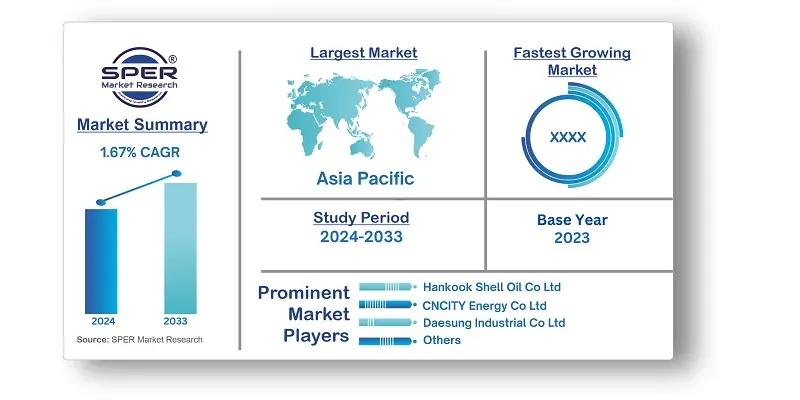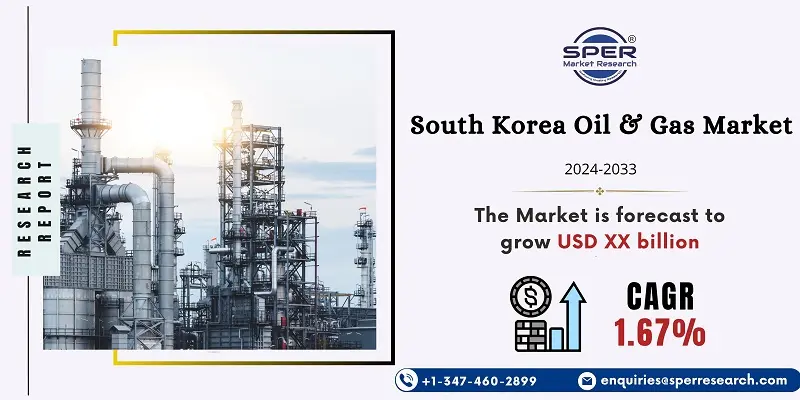
South Korea Oil and Gas Market Growth, Size, Trends, Share, Revenue, Demand and Future Outlook
South Korea Oil and Gas Market Size- By Type, By Application- Regional Outlook, Competitive Strategies and Segment Forecast to 2033
| Published: Jun-2024 | Report ID: POAE2453 | Pages: 1 - 107 | Formats*: |
| Category : Power & Energy | |||
- In January 2022, the country passed a resolution classifying LNG as a green fuel as part of its decarbonisation plan aimed at achieving the clean energy transition. This move is expected to impact green funding, the course of carbon taxes and emissions caps, the timetable for the decommissioning of coal-fired plants, and South Korea's future energy mix.
- In July 2021, South Korea's state-run Korea Gas Corp (KOGAS) inked a 20-year LNG supply agreement with Qatar, which would begin in 2025. The contract states that KOGAS will purchase 2 million tonnes of LNG per year from Qatar Petroleum. According to the energy ministry, KOGAS buys 9 million tonnes of LNG from Qatar each year under long-term contracts, with a contract worth 4.9 million tonnes of LNG set to expire in 2024.


| Report Metric | Details |
| Market size available for years | 2020-2033 |
| Base year considered | 2023 |
| Forecast period | 2024-2033 |
| Segments covered | By Type, By Application |
| Regions covered | Seoul Capital Area, Yeongnam (Southeastern Region), Honam (Southwestern Region), Hoseo (Central Region) |
| Companies Covered | Hankook Shell Oil Co Ltd, CNCITY Energy Co Ltd, Daesung Industrial Co Ltd, GS Caltex Corp, SGS Group, Korea National Oil Corporation, Korea Gas Corporation, S-Oil Corporation, SK Energy, Hyundai Oilbank Co Ltd, Kukdong Oil & Chemicals Co Ltd. |
- Energy Companies
- Investors and Financial Institutions
- Government and Regulatory Bodies
- Suppliers and Service Providers
- Research and Consulting Firms
| By Type: | |
| By Application: |
- South Korea Oil & Gas Market Size (FY’2024-FY’2033)
- Overview of South Korea Oil & Gas Market
- Segmentation of South Korea Oil & Gas Market By Type (Upstream, Midstream, Downstream)
- Segmentation of South Korea Oil & Gas Market By Application (Residential, Commercial, Industrial, Others)
- Statistical Snap of South Korea Oil & Gas Market
- Expansion Analysis of South Korea Oil & Gas Market
- Problems and Obstacles in South Korea Oil & Gas Market
- Competitive Landscape in the South Korea Oil & Gas Market
- Impact of COVID-19 and Demonetization on South Korea Oil & Gas Market
- Details on Current Investment in South Korea Oil & Gas Market
- Competitive Analysis of South Korea Oil & Gas Market
- Prominent Players in the South Korea Oil & Gas Market
- SWOT Analysis of South Korea Oil & Gas Market
- South Korea Oil & Gas Market Future Outlook and Projections (FY’2024-FY’2033)
- Recommendations from Analyst
1.1. Scope of the report1.2. Market segment analysis
2.1. Research data source
2.1.1. Secondary Data2.1.2. Primary Data2.1.3. SPER’s internal database2.1.4. Premium insight from KOL’s
2.2. Market size estimation
2.2.1. Top-down and Bottom-up approach
2.3. Data triangulation
4.1. Driver, Restraint, Opportunity and Challenges analysis
4.1.1. Drivers4.1.2. Restraints4.1.3. Opportunities4.1.4. Challenges
4.2. COVID-19 Impacts of the South Korea Oil & Gas Market.
5.1. SWOT Analysis
5.1.1. Strengths5.1.2. Weaknesses5.1.3. Opportunities5.1.4. Threats
5.2. PESTEL Analysis
5.2.1. Political Landscape5.2.2. Economic Landscape5.2.3. Social Landscape5.2.4. Technological Landscape5.2.5. Environmental Landscape5.2.6. Legal Landscape
5.3. PORTER’s Five Forces
5.3.1. Bargaining power of suppliers5.3.2. Bargaining power of buyers5.3.3. Threat of Substitute5.3.4. Threat of new entrant5.3.5. Competitive rivalry
5.4. Heat Map Analysis
6.1. South Korea Oil & Gas Market Manufacturing Base Distribution, Sales Area, Product Type6.2. Mergers & Acquisitions, Partnerships, Product Launch, and Collaboration in South Korea Oil & Gas Market
7.1. South Korea Oil & Gas Market Size, Share and Forecast, By Type, 2020-20267.2. South Korea Oil & Gas Market Size, Share and Forecast, By Type, 2027-20337.3. Upstream7.4. Midstream7.5. Downstream
8.1. South Korea Oil & Gas Market Size, Share and Forecast, By Application, 2020-20268.2. South Korea Oil & Gas Market Size, Share and Forecast, By Application, 2027-20338.3. Residential8.4. Commercial8.5. Industrial8.6. Others
9.1. South Korea Oil & Gas Market Size and Market Share
10.1. South Korea Oil & Gas Market Size and Market Share By Region (2020-2026)10.2. South Korea Oil & Gas Market Size and Market Share By Region (2027-2033)
10.2.1. Seoul Capital Area10.2.2. Yeongnam (Southeastern Region)10.2.3. Honam (Southwestern Region)10.2.4. Hoseo (Central Region)10.2.5. Others
11.1. Hankook Shell Oil Co Ltd
11.1.1. Company details11.1.2. Financial outlook11.1.3. Product summary11.1.4. Recent developments
11.2. CNCITY Energy Co Ltd
11.2.1. Company details11.2.2. Financial outlook11.2.3. Product summary11.2.4. Recent developments
11.3. Daesung Industrial Co Ltd
11.3.1. Company details11.3.2. Financial outlook11.3.3. Product summary11.3.4. Recent developments
11.4. GS Caltex Corp
11.4.1. Company details11.4.2. Financial outlook11.4.3. Product summary11.4.4. Recent developments
11.5. SGS Group
11.5.1. Company details11.5.2. Financial outlook11.5.3. Product summary11.5.4. Recent developments
11.6. Korea National Oil Corporation
11.6.1. Company details11.6.2. Financial outlook11.6.3. Product summary11.6.4. Recent developments
11.7. Korea Gas Corporation
11.7.1. Company details11.7.2. Financial outlook11.7.3. Product summary11.7.4. Recent developments
11.8. S-Oil Corporation
11.8.1. Company details11.8.2. Financial outlook11.8.3. Product summary11.8.4. Recent developments
11.9. SK Energy
11.9.1. Company details11.9.2. Financial outlook11.9.3. Product summary11.9.4. Recent developments
11.10. Hyundai Oilbank Co Ltd
11.10.1. Company details11.10.2. Financial outlook11.10.3. Product summary11.10.4. Recent developments
11.11. Kukdong Oil & Chemicals Co Ltd
11.11.1. Company details11.11.2. Financial outlook11.11.3. Product summary11.11.4. Recent developments
11.12. Others
SPER Market Research’s methodology uses great emphasis on primary research to ensure that the market intelligence insights are up to date, reliable and accurate. Primary interviews are done with players involved in each phase of a supply chain to analyze the market forecasting. The secondary research method is used to help you fully understand how the future markets and the spending patterns look likes.
The report is based on in-depth qualitative and quantitative analysis of the Product Market. The quantitative analysis involves the application of various projection and sampling techniques. The qualitative analysis involves primary interviews, surveys, and vendor briefings. The data gathered as a result of these processes are validated through experts opinion. Our research methodology entails an ideal mixture of primary and secondary initiatives.



Frequently Asked Questions About This Report
PLACE AN ORDER
Year End Discount
Sample Report
Pre-Purchase Inquiry
NEED CUSTOMIZATION?
Request CustomizationCALL OR EMAIL US
100% Secure Payment






Related Reports
Our Global Clients
Our data-driven insights have influenced the strategy of 200+ reputed companies across the globe.






















